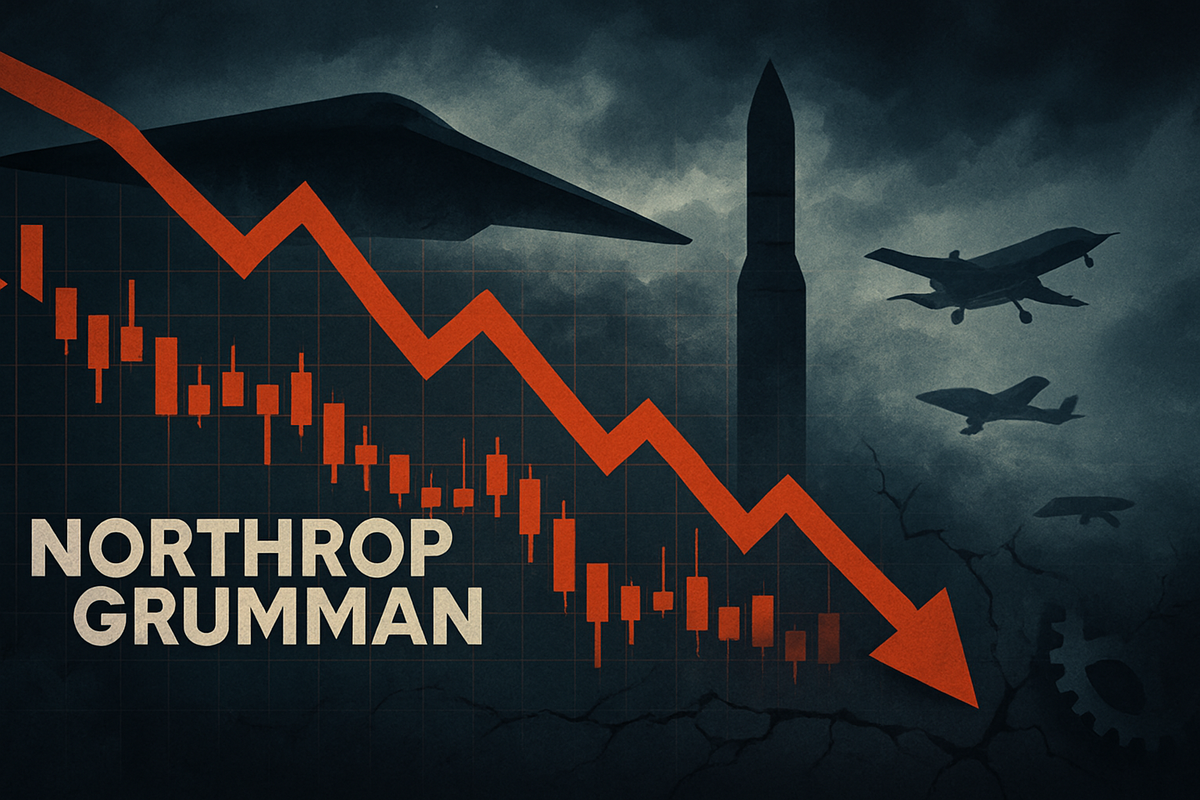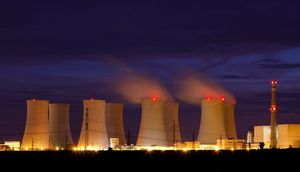
Northrop Grumman (NYSE: NOC), a titan in the aerospace and defense sector, is currently navigating a turbulent period, positioning it as a significant "bottom mover" in the stock market as of October 15, 2025. The company's stock has faced considerable downward pressure stemming from multi-billion dollar cost overruns on its critical Sentinel Intercontinental Ballistic Missile (ICBM) program, substantial losses on the B-21 Raider stealth bomber, and broader industry concerns regarding capital allocation. These developments have not only eroded investor confidence but also prompted a re-evaluation of the company's financial outlook and program management capabilities.
The immediate implications for Northrop Grumman are severe, with lowered earnings per share (EPS) forecasts and a direct impact on profitability. The critical Nunn-McCurdy breach on the Sentinel program, in particular, introduces significant uncertainty, raising the specter of further restructuring or even termination, which would be a colossal blow to a cornerstone of the nation's nuclear deterrence strategy. For the wider market, these challenges highlight the inherent risks in large-scale, long-duration defense contracts and signal potential shifts in government oversight and expectations for industry giants.
Detailed Program Challenges Unfold
Northrop Grumman's current market position is largely a consequence of several high-profile program difficulties. The most significant is the Sentinel ICBM program, intended to replace the aging Minuteman III missiles. This vital nuclear modernization effort has seen its estimated total cost surge by an alarming 81% from its initial projection, now reaching an estimated $141 billion. This massive increase triggered a critical Nunn-McCurdy breach, necessitating a formal review by the Office of the Secretary of Defense. The primary driver for these overruns was a flawed initial assumption that existing Minuteman III silos could be refurbished, leading to the unexpected requirement for constructing entirely new, more expensive ground infrastructure, including replacing 7,500 miles of copper cabling with fiber optics. As a result, the program's planned transition from Minuteman III is now significantly delayed, with the first developmental flight test for the missile pushed back, and a September 2025 Government Accountability Office (GAO) report highlighting persistent risks to both cost and schedule.
Compounding these issues are the financial setbacks on the B-21 Raider stealth bomber program. Northrop Grumman reported a $477 million loss on the B-21 in the first quarter of 2025, bringing the total losses on the program to over $2 billion since late 2023. These losses are primarily attributed to higher-than-expected manufacturing and materials costs for the low-rate initial production (LRIP) lots, as well as adjustments to the production process aimed at accelerating build rates. This directly impacted Northrop Grumman's profitability, contributing to a $183 million loss in its aeronautics systems division and a 46% decline in overall operating income compared to Q1 2024. The company subsequently lowered its projected earnings per share (EPS) for the year, further dampening investor sentiment.
Adding to the company's woes was the loss of the lucrative Collaborative Combat Aircraft (CCA) contract. In May 2024, Northrop Grumman, along with industry stalwarts Boeing (NYSE: BA) and Lockheed Martin (NYSE: LMT), was eliminated from the initial Air Force CCA Increment 1 competition. This potentially $30 billion contract, aimed at developing autonomous drone wingmen, was instead awarded to privately held General Atomics and Anduril Industries. While this event occurred earlier in the year, the estimated lost potential revenue represents a significant missed opportunity in a critical emerging defense area, signaling a shift in preferred vendors for certain cutting-edge autonomous platforms. Most recently, on October 15, 2025, Northrop Grumman's stock slid 3.4% following remarks from Treasury Secretary Scott Bessent, suggesting that the government might request defense companies to reduce share repurchases amidst increasing federal spending on national security, triggering an industry-wide sell-off.
Shifting Fortunes: Winners and Losers in the Defense Landscape
Northrop Grumman's recent challenges are creating a dynamic environment within the defense industry, leading to a realignment of opportunities and risks for various players.
The most immediate beneficiaries of Northrop Grumman's setbacks in the autonomous systems domain are Anduril Industries and General Atomics. Having secured the Air Force's initial CCA Increment 1 contract, and subsequently Navy CCA contracts in September 2025, these privately held companies are now at the forefront of developing next-generation autonomous combat aircraft. Their success positions them as formidable contenders in a rapidly expanding market, potentially attracting further investment and reshaping the competitive landscape for future defense procurements. Furthermore, the Air Force's consideration of opening up elements of the Sentinel program's ground infrastructure to new competition could create significant opportunities for other engineering and construction firms, such as KBR (NYSE: KBR), Jacobs Engineering (NYSE: J), and Fluor (NYSE: FLR), should they be able to offer more cost-effective solutions for rebuilding missile silos and associated infrastructure.
While initially losing out on the Air Force CCA program, established primes like Lockheed Martin (NYSE: LMT) and Boeing (NYSE: BA) have demonstrated resilience and strategic adaptability. Both companies secured Navy CCA design and development contracts in September 2025, specifically focusing on critical areas like common control systems (for Lockheed Martin). These wins help mitigate the impact of the Air Force CCA loss and ensure their continued relevance in the broader Next Generation Air Dominance (NGAD) initiative, which encompasses CCA. Such strategic positioning could positively influence their stock performance by showcasing their ability to adapt and compete in advanced aerospace capabilities. Conversely, Northrop Grumman itself faces continued pressure on its stock performance and market share, particularly in emerging technology segments where agile competitors are gaining ground.
Northrop Grumman's extensive supply chain partners for the B-21 and Sentinel programs, including companies like Pratt & Whitney (NYSE: RTX), Collins Aerospace (NYSE: RTX), BAE Systems (LON: BAES), and Spirit AeroSystems (NYSE: SPR), could also face ripple effects. While the long-term intent to increase B-21 production is positive, Northrop's current losses on the program may lead to increased pressure on these suppliers for cost reductions or renegotiated terms. Similarly, suppliers for the Sentinel program could experience uncertainty or revised contract terms due to the program's restructuring and the potential for new competition in the ground infrastructure segment, impacting their revenue streams and stability.
Broader Implications and Industry Crossroads
Northrop Grumman's current struggles are not isolated incidents but rather symptomatic of broader trends and systemic challenges within the defense industry. These issues intersect with a critical period of technological modernization, rising global tensions, and an increased emphasis on affordability and speed in defense procurement.
The significant cost overruns on the Sentinel program underscore the inherent complexities and risks associated with fixed-price contracts for highly intricate, multi-decade defense initiatives, particularly when confronted with unforeseen design changes and inflationary pressures. This situation amplifies the ongoing debate around defense acquisition reform, pushing for more adaptive strategies that balance innovation with fiscal responsibility. The critical Nunn-McCurdy breach itself triggers heightened regulatory scrutiny, aligning with broader efforts by the Department of Defense to streamline procurement processes and reduce barriers to innovation. The U.S. Treasury Secretary's recent remarks on share repurchases also signal a potential policy shift, encouraging defense contractors to prioritize reinvestment in production and workforce development over shareholder returns, which could affect capital allocation strategies across the entire sector.
The loss of the Air Force CCA contract to non-traditional defense players like Anduril and General Atomics highlights a pivotal shift in the competitive landscape. This signifies a growing imperative for traditional primes to adapt to new acquisition models and compete with agile, technology-focused newcomers in rapidly evolving domains such as autonomous systems and artificial intelligence. This trend could accelerate the diversification of the defense industrial base, potentially fostering greater innovation but also challenging the dominance of long-established contractors. Historically, major defense programs have often faced similar challenges; examples like the Littoral Combat Ship (LCS) and the F-35 program have encountered massive budget overruns and delays, leading to reevaluation and budget diversions, demonstrating that Northrop Grumman's current predicament is not without precedent.
Furthermore, these challenges have ripple effects across the entire defense supply chain. Strain on subcontractors and suppliers, particularly smaller businesses, could exacerbate existing vulnerabilities, potentially leading to further consolidation within the industrial base. The problems also underscore the urgent need for greater supply chain resilience, especially in light of geopolitical tensions and potential restrictions on critical materials, such as China's escalated rare earth export restrictions in October 2025. This could push for diversification of suppliers and increased onshoring of critical components to safeguard national security interests and mitigate future disruptions.
The Path Forward: Scenarios and Strategic Pivots
Northrop Grumman is navigating a pivotal period, with its short-term stability and long-term trajectory hinging on its ability to execute strategic pivots and adapt to a rapidly evolving defense landscape. Despite the recent setbacks, the company's robust backlog of nearly $93 billion provides a strong foundation.
In the short-term (next 1-2 years), Northrop Grumman must demonstrate effective management of the B-21 losses, with analysts anticipating the program will achieve profitability post-2026 as production matures. The Sentinel program, despite its overruns, is expected to continue with strong government commitment due to its national security imperative, though some restructuring of ground infrastructure contracts to mitigate costs remains a possibility. The company's involvement in the Navy's CCA program offers a crucial opportunity to re-establish a foothold in autonomous systems, offsetting the Air Force CCA loss. Strategically, Northrop Grumman is focusing on accelerating international sales, which are projected to grow faster than domestic sales, particularly in regions like Saudi Arabia, Qatar, and the UAE for integrated air and missile defense systems.
Looking at the long-term (3-5 years and beyond), the B-21 program is expected to become a significant driver of revenue and free cash flow, and the Sentinel program, once fully operational, will secure its place as a critical national asset. Northrop Grumman is also intensifying its focus on core defense technologies, ramping up existing programs, and making strategic investments in areas like solid rocket motors, aiming to significantly increase annual production. The company is optimizing its portfolio through divestitures, such as the planned sale of its Training Services business by mid-2025, to sharpen its focus on core defense capabilities. Investments in Research & Development and infrastructure, totaling $13.5 billion over the last five years, are geared towards technological differentiation in advanced missile defense, airborne ISR, and command and control (C2) systems. Market opportunities abound with growing global defense spending, modernization demands, and the operationalization of emerging technologies like AI and unmanned systems. However, challenges persist, including programmatic risks from fixed-price contracts, supply chain vulnerabilities (exacerbated by rare earth restrictions), intensified competition from agile startups, and potential U.S. budget scrutiny.
Potential scenarios range from a Resilient Recovery and Diversified Growth (base case), where Northrop Grumman effectively manages program challenges, leverages its strong backlog, and expands internationally, to a Persistent Program Headwinds and Competitive Erosion scenario, where losses prove more protracted, market share in emerging tech is lost, and the stock underperforms. A third scenario, Adaptive Transformation and Niche Leadership, sees Northrop Grumman proactively engaging on program risks, aggressively pursuing new opportunities (like Navy CCA), and strategically investing in high-end, technologically advanced solutions, ultimately transforming into a more specialized and resilient defense leader.
Wrap-Up: Navigating Turbulence Towards a Strategic Future
Northrop Grumman's journey through 2025 has been marked by significant program-specific challenges, notably the multi-billion dollar cost overruns on the Sentinel ICBM program and substantial financial losses tied to the B-21 Raider stealth bomber's initial production. The loss of the Air Force's primary Collaborative Combat Aircraft (CCA) contract further underscored the evolving competitive landscape in advanced defense technologies. These events have collectively positioned Northrop Grumman as a "bottom mover" in the market, impacting its short-term profitability and investor sentiment.
The key takeaways from this period are clear: the inherent financial risks of large-scale fixed-price defense contracts, especially amidst inflationary pressures and unforeseen complexities; the critical balance between national security modernization imperatives and the practical realities of managing massive programs; and the undeniable shift in the defense industry towards agile, innovative players in emerging technology domains. Despite these setbacks, the Pentagon's unwavering commitment to the Sentinel and B-21 programs highlights their strategic importance to U.S. national security, providing a long-term revenue stream for Northrop Grumman. The company's resilience is also evidenced by its continued involvement in the Navy's CCA program and its strategic focus on international expansion and core defense technologies.
Moving forward, the market trajectory for Northrop Grumman appears mixed but generally positive within the broader context of a robust defense industry. While Q1 2025 saw profit declines, stronger Q2 revenues indicate some operational recovery. Analyst sentiment, as of October 2025, largely maintains a "Moderate Buy" rating, reflecting confidence in the company's long-term prospects. The lasting impact of these challenges will depend on Northrop Grumman's ability to effectively manage ongoing program complexities, transition the B-21 to profitable full-rate production, and strategically adapt to new competitive dynamics in areas like autonomous systems.
Investors should closely watch several factors in the coming months. Northrop Grumman's upcoming Q3 2025 earnings release (October 21, 2025) will provide crucial insights into its financial health and program management. Updates on the Sentinel program's restructuring and the Air Force's efforts to identify cost-saving measures will be critical. Progress on accelerating B-21 production and any agreements to improve returns on LRIP will be key indicators for future profitability. Furthermore, developments in both Air Force and Navy CCA programs, and Northrop Grumman's role within them, will signal its strategic positioning in next-generation warfare. Finally, the broader geopolitical landscape, U.S. defense budget allocations, and the company's ability to navigate supply chain disruptions and inflation will continue to influence its performance.
This content is intended for informational purposes only and is not financial advice






